HOMILY FOR THE MIDNIGHT MASS OF THE NATIVITY OF THE LORD
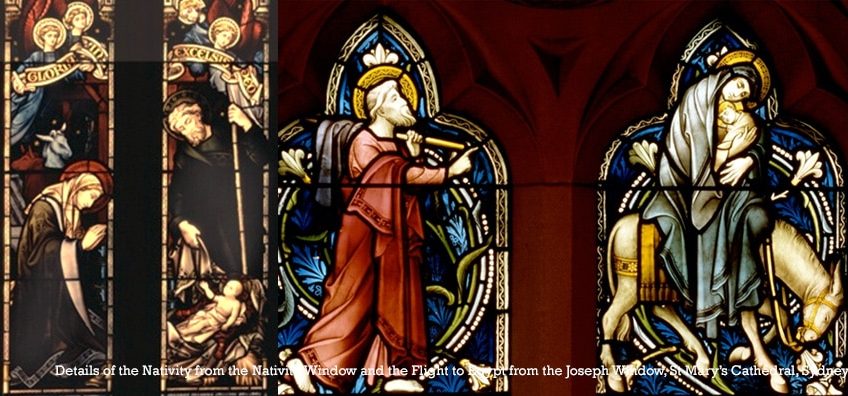
St Mary’s Cathedral Basilica, Sydney
The isolation of Christmas…
Christmas can be very isolating. Think of the teenager with the strange story about how she got pregnant (Lk 1:26-38; Mt 1:18). Amidst all the village gossip, she went off to the hills to stay with an aunt (Lk 1:39-56); when she got back tongues were still wagging and people socially distancing from her as if she were a leper. Even her betrothed took some convincing not to put her out of sight (Mt 1:19-25). Months later, and now heavily pregnant, she was forced by unsympathetic authorities to take the road to Bethlehem with her husband (Lk 2:1-6).
Details of the Nativity from the Nativity Window and the Flight to Egypt from the Joseph Window, St Mary’s Cathedral, Sydney
: Once again no-one wanted her. She had to give birth in a stable (Lk 2:7). No mother or sisters to help. Then they had to flee as refugees from a government intent on killing the little one (Mt 2:16-18). No goodbyes to loved ones. So the boy was destined to spend his first years in exile. As He grew up he had many more experiences of seclusion, and while He valued solitude for prayer and contemplation,[1] He also loved human company[2] and experienced desolation when He was abandoned.[3] At His first Christmas distancing was the order of the day…
For some people Christmas is an especially lonesome time, often because they too are separated from family and friends. It might be due to geography or some deep divide with long no-speaks. Perhaps there’s no-one even to be neglecting them. Seeing people gathering and jolly only rubs salt into the wound. Contrary to urban myth,[4] rates of depression and self-harm actually go down at this time of year,[5] but we understand how sequestered some people feel…
This year we’ve all had that experience. A year of anxiety about health, finances, family and friends. Of curtailed work, study, leisure, culture and worship. Of closed borders and locked-down cities, masking and zooming, social distancing and self-isolation. Such things are hard for social beings like us. We crave company and intimacy. We miss each other’s eyes, touch, proximity.
…but God comes close…
It was precisely in such dark times that Christ’s coming was experienced as Light.[6] Amidst grave danger that He was experienced as ‘Yeshua’, Jesus, meaning ‘God saves’.[7] Just when people felt most isolated that He was Emmanuel, ‘God with us’.[8]
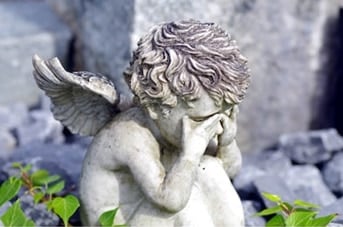
It’s said that the angels weep when a champagne cork is popped because they will never taste champagne. Pure spirits like God and the angels have no bodies, no geography, no proximity. Only material beings can have a location, move from place to place, or be close or far from each other. We think of God or angels as ‘present’ wherever they affect the material world, but strictly speaking they are not, at least not in the sense that material beings can be present to each other. It was only when the Word took flesh and dwelt amongst us (Jn 1:1-18), only when God became one of us in Jesus, that God could literally come close.
What better proof is there of God’s with-us-ness than that He became a little child, as weak and vulnerable as any human being? What clearer demonstration of Christ’s like-us-ness than His joining a family, friends, people? What plainer testimonial to His for-us-ness than that He was willing to bear all the weight of human sin and suffering, anxiety and loneliness, even to the cross, so as to offer the hope of Resurrection beyond?[9]
While many people think of God as distant, the baby Jesus is God come close. His birth makes a family into which others can be adopted. His weakness invites everyone to His crib, even shepherds and other outcasts (Lk 2:8-20). His light guides wise men through the wilderness (Mt 2:1-12) and will get us through the desert of COVID-19 and worse. As the Babe reaches out to us we cannot resist taking Him in our arms; but as we do, we experience the embrace of the God of all creation and Lord of the universe.
…so that we might come closer to God and each other
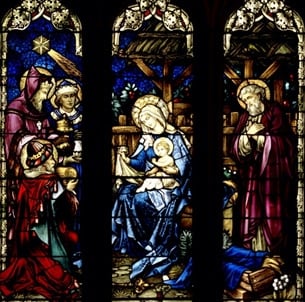
Like a magnet the Christmas Babe draws a young woman and older man, heavenly angels, foreign kings and local shepherds – in other words, everyone (cˆf. Jn 12:32). Like an antidote to social distancing, He unites all sorts as a single new people.[10] God-come-close brings us closer to one another.
By God’s grace and thanks to our leaders, frontline workers and whole community, we Australians have (so far) been spared the worst of this pandemic. The level of cooperation is a tribute to the value we place upon life and especially our elders. But we must remain vigilant in the face of the virus and any other threats to life or the elderly. This Christmas, let’s give thanks that we are safe and pray for those not so fortunate.
Five years ago at Christmas I exhibited the first symptoms of Guillain-Barré Syndrome. Within hours I was in intensive care, totally immobile from the neck down, close to death. I spent five months in hospital recovering, while experiencing paralysis and pain, humiliation and total dependence. I learnt a lot about human weakness and need, compassion and care. Prayer and company, healthcare and physio, together brought relief and ultimately complete cure. I continue to this day to unpack the meaning of it all. I would not wish it on anyone. But there were unexpected graces amidst the suffering that I must not forget.
Understandably, many people just want to put this year behind them and get back to normal. But if, like my time in hospital, our enforced retreat has meant the getting of some wisdom about human vulnerability and interconnectedness, we must not lose it afterwards. This Christmas, let’s take a few moments to reflect upon what we’ve learnt in the Year of COVID.
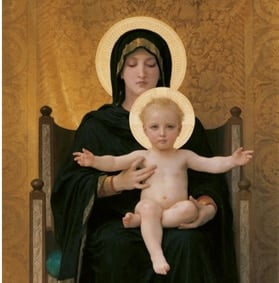
We might also consider how we’ll be different, individually and as a community, when it’s all over. Having reassessed our priorities, will we now focus on what really matters? After longing for each other’s company, will we be there for each other in future? Having experienced the upsides of spending more time with our families, will we ensure we do so hereafter? After missing work colleagues, school friends, customers and neighbours, will we treasure them going forward? This Christmas, let’s commit ourselves to ending all unnecessary distancing, to bringing people together, and to liberating the physically isolated or emotionally locked-down.
The Christmas God is not into distancing. Because we were lonely and lost, He came close. From His crib He reaches out to us and we can in turn reach out to others. The smile of the Babe of Bethlehem is happiness and hope for every human heart (Isa 52:7-10). He smiles at you this Christmas. :
WORDS OF THANKS AFTER THE MIDNIGHT MASS OF THE NATIVITY OF THE LORD
St Mary’s Basilica, Sydney
It’s always a joy to celebrate the Lord’s Nativity with you, but especially so this year, amidst restrictions preventing so many from being physically present. Again I say to all of you watching on-line: we miss you!
My thanks to all those who have contributed to tonight’s celebration, including our concelebrants and deacons. Dean Don Richardson, Master of Ceremonies Fr Lewi Barakat, Precinct Manager Helen Morassut and Sacristan Chris Backhouse – with their teams of clergy, acolytes and servers, extraordinary ministers and lectors, ushers, staff and volunteers. They ensure that our liturgical life is worthy not just at Christmas but all year round. In this year of COVID they’ve had to adapt to changing conditions and keep our worshippers safe.
In a year in which the arts and worship have not always received the support they should, our Director of Music, Thomas Wilson, and our wonderful choirs and musicians, have enabled us safely to join the angels singing glory to God in heaven and peace to people on earth. They have carried us through when our congregations have been prohibited from singing, and have been flexible and generous throughout. For this we are all grateful.
Tonight, as we broke into song with the angels, rejoicing in a God who comes close and draws us closer to each other, we resolve to learn from the year we have experienced, and to be there for others in the year ahead. On behalf of all of us at St Mary’s Cathedral I wish you and your loved ones every blessing of this holy season of Christmas and of the New Year of Grace 2021.
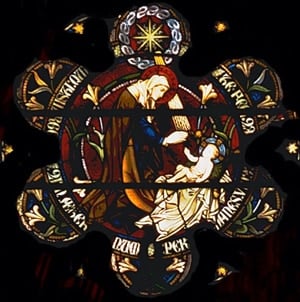
INTRODUCTION TO THE MIDNIGHT MASS OF THE NATIVITY OF THE LORD
St Mary’s Basilica, Sydney
People of Sydney I bring you news of great joy, a joy to be shared by the whole people: today in the city of David a Saviour has been born to you: He is Christ the Lord (Lk 2:11).
Welcome to St Mary’s Cathedral for this midnight celebration of the Nativity of the Lord. I offer this Mass for you and all your loved ones, that after a year of separation and anxiety, you may experience what the angels promise us tonight: the heavenly glory of God and the earthly goodwill of people (Lk 2:14).
In a normal year this cathedral would be full to capacity with several thousand people at this Mass. But this year we were told we could only have 1200. Even with putting on extra Masses this meant all places were fully booked at this and other Masses. Then just this week the authorities further reduced us to 300. To the hundreds of disappointed people: my sincere apologies. We miss you! So let’s first sweep out the manger of our souls by repenting of our sins, and so prepare our hearts to be a crib into which to receive the Child-child…
[1] Mt 14:1-13; Mk 6:30-32; Lk 4:1-2,14-15; 5:16; 6:12-13; 22:39-44 et par.
[2] Mt 17:1; Mk 5:37; Lk 5:27-32; 7:36-50; 9:10-17 et par; 10:38-42; 14:1-24; 19:1-10; 22:14-38 et par; 24:28-32,36-43; Jn 11:35; 13:1; 14:13; 15:13-14; etc.
[3] Mk 15:33-34; cf. Mt 26:56; Mk 14:50-52; Lk 22:60-61; Jn 11:35.
[4] Emma Barker, John O’Gorman and Diego de Leo, ‘Suicide around public holidays,’ Australasian Psychiatry 22(2) (Apr 2014), 122-26; Nathan Morris, ‘Suicide prevention team says holiday season is high-risk time,’ ABC Goldfields, 16 December 2015 https://www.abc.net.au/news/2015-12-16/festive-season-suicide-risk/7035470
[5] Vladeta Ajdacic-Gross et al., ‘Reduction in the suicide rate during Advent: A time series analysis,’ Psychiatry Research 157 (2008), 139-46; Sharon Begley, ‘Christmas suicide surge is a myth, but what about the January rebound?’ STAT 30 December 2015; Helen Bergen and Keith Hawton, ‘Variation in deliberate self-harm around Christmas and New Year,’ Social Science & Medicine 65(5) (Sept 2007), 855-67; Neel Burton, ‘Is suicide more common at Christmas time?’ Psychology Today 20 December 2017; Simon Carley and Mark Hamilton, ‘Suicide at Christmas,’ Emergency Medicine Journal 21(6) (2004), 716-7; Relationships Australia, ‘Family stress at Christmas time,’ Relationships Australia, December 2014 https://www.relationships.org.au/what-we-do/research/online-survey/mid-december-2014-family-stress-at-christmas-time; Tori Rodriguez, ‘The Christmastide suicide myth,’ Scientific American Mind 27(6) (November 2016).
[6] Isa 9:1-7; Heb 1:1-6 etc.
[7] Mt 1:21,25; Lk 1:31; 2:21.
[8] Mt 1:23.
[9] 2Cor 5:21; Phil 2:7; Heb 4:15.
[10] Cf. Tit 2:11-14; Acts 21:5-11; Rev 5:9 etc.

